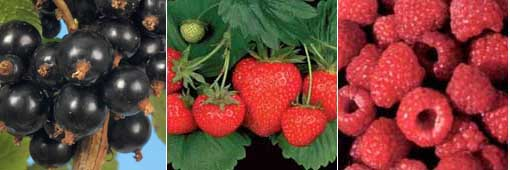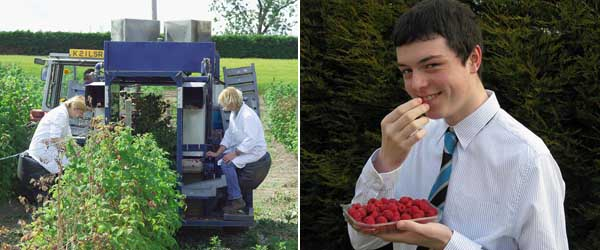Soft Fruit and Human Health
Published on 19 March 2009 in Food, health and wellbeing
Introduction
The agricultural policies of the developed world have meant that, for these countries at least, food is plentiful but changing eating patterns have seen an increase in the consumption of ready-made meals and food elevated with respect to sugar and fat. The knock-on effect of this is evident in the rapidly increasing level of obesity in the western world with 22% of males and 24% of females now classified as obese in the Scotland. Worryingly the levels amongst the young are significant with the latest NHS figures for primary one schoolchildren showing that 8.2 % boys and 7.6% girls are classed as obese. In fact within the same year 20.5% and 19.6% of the primary one boys and girls, respectively, were classed as overweight. This level of excess weight at such an early age is storing up problems for later life with elevated or excessive weight associated with an increased in incidence of conditions such as diabetes and atherosclerosis .
Key Points

Image: Scottish soft fruit (from left): blackcurrants, strawberries and raspberries.
Scotland's poor ill-health record has been recognised and needs to be addressed with more radical policy solutions. The link between the incidence of obesity and the degenerative clinical conditions highlighted above is becoming increasingly irrefutable. Furthermore the accretion of supportive evidence for the benefits of a diet high in plant derived food in reducing the onset of degenerative diseases has led to many fundamental and clinical intervention studies to identify the phytochemical components driving these effects. The direct effect of plant-derived vitamins on human health has been comprehensively covered in many clinical and intervention studies but it is the other plant components, specifically the polyphenolics that are currently under intense focus with respect to their bioefficacy as natural, dietary means to improving health and reducing the incidence of degenerative disease.

Figure 1: The varied classes of phytochemicals.
The polyphenolics are a complex class of plant natural chemicals with diverse chemical structures present in a broad range of our common foods. Soft fruit are a particularly rich source of these compounds. For example the anthocyanins are the compounds responsible for giving soft fruit, such as raspberry, blackcurrant and strawberry, their deep alluring colours. In addition, the complex group of compounds, the ellagitannins, are responsible for some of the tartness in raspberries. The emerging research into the utility and efficacy of these compounds extends beyond their known value in fruit taste and appearance and into their impact on human health.
Research Undertaken
Using the high quality fruit produced in Scotland and the established soft fruit phytochemistry and genetics research programmes in place at SCRI as a starting point collaborations are ongoing with biomedical groups at the universities of Dundee, Ulster, Glasgow etc., using model (cell) systems and intervention trials to establish the degree and basis of the beneficial effects of these polyphenolic soft fruit components. Research into the effects of these compounds on human health has already provided some intriguing data. These effects include the following.
- A stimulation of the formative mechanisms of the bodies own cancer defences.
- The ability to selectively reduce the proliferation and invasiveness of colon cancer in model systems. See figure below.
- A combined benefit to arteries by a reduction in stress damage and increased flexibility (effect implies a reduction in blood pressure and a reduction in the risk of aneurysm).
- An ability to inhibit starch and complex fat digestion thereby potentially aiding obesity reduction.

Figure 2: Evidence of anti-cancer effects of berry polyphenols in specified conditions.
Furthermore, recent studies into another group of complex polyphenols, the procyanidins have shown that they appear to mimic insulin-like effects on the genes and enzymes that regulate the rate of ageing in response to dietary cues. This is apposite since there has been an alarming rise in the levels of diabetes by 74% between 1997 and 2003 and with the latest figures (2008) reporting that 3.7% of the Scottish population have diabetes. Diabetes is intimately linked with the onset of other conditions such as heart disease, stroke, kidney failure and blindness and the associated costs to NHS Scotland are £114,000 an hour. A reduction on the incidence of diabetes and the other degenerative conditions, particular via dietary means, remains a clear goal for future research.
As proof continues to accrue regarding the beneficial effects of the soft fruit polyphenols this is being fed back into the plant based scientific research and related breeding programmes with a view to elevating the levels of these compounds in new varieties whilst maintaining the desirable taste and texture. To achieve this research is ongoing to determine, and then utilise, the biodiversity of general and select polyphenol levels in wild and cultivated soft fruit. This research is also addressing the impact that the growing environment and ultimately climate change has on these health beneficial properties and how we can best manage and exploit these factors in a sustainable manner to the benefit of the Scottish health and economy.

Figure 3: Variation of total anthocyanin content withing a crossed raspberry population (Glen Moy x Letham) grown in two distinct environments.
Policy Implications
The continued exploration of the health benefits of high quality soft fruit crops bred and grown in Scotland aligns fully with the higher aims of the Scottish Government: a smarter, greener, healthier, wealthier and fairer, and safer and stronger Scotland. At the practical level we must continue to elucidate the mechanisms by which the soft fruit components have their impact on health to ensure we are breeding for the most appropriate constituents. This will go a significant way towards addressing existing policy on diet and health, Improving Health in Scotland - The Challenge (Scottish Government, 2003) which aims to improve the childhood diet thereby ensuring that Scotland has well-nourished, well-balanced and healthy children.

Image: Raspberry harvesting by machine (left) and a teenager enjoying Scottish raspberries.
The fruits we develop must not only be more nutritious but also flavoursome and visually appealing to encourage repeat purchases and increased consumption of fruit with proven nutritional benefits. There must also be opportunities for the formulation of new, nutritionally enhanced soft fruit products which appeal to all age ranges. It is important that Scotland’s position as a source of premium high quality soft fruit is maintained and research must rise to the challenges posed by the need for the sustainable production of these crops under changing climates and imposed patterns of agrochemical usage via EU legislation.
Author
Dr Derek Stewart, Head of Plant Products and Food Quality, Dr Rex Brennan, SCRI Derek.Stewart@scri.ac.uk







